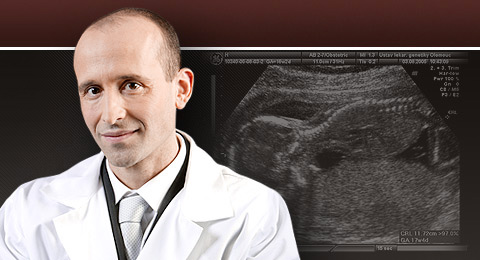Procházka M., Lubusky M., Slavík L., Hrachovec P., Zielina P., Kudela M., Lindqvist P. G. Selected pregnancy variables in women with placental abruption. Bimed. Pap. Med. Fac. Univ. Palacky Olomouc Czech Repub., 2006, 150 (2), p. 271-273.
Introduction
Premature separation of the placenta occurs in only 1 % of all pregnancies, yet it is an important cause of stillbirth, preterm delivery, early neonatal death and even maternal death1. Placental abruptio accounts for 20 % to 25 % of antepartum hemorrhages. The perinatal mortality rate varies between 2 % and 67 %, depending on gestational age, fetal weight, and the degree of abruptio. Over 50 % of all perinatal deaths occur before delivery2. Placental abruptio is defined as the separation of a normally implanted placenta, usually by hemorrhage into the decidua basalis. Abruptio itself usually manifests as painful uterine bleeding and uterine irritability, sometimes in conjunction with fetal distress and maternal coagulation abnormalities.
The aim of our study was determine risk factors and to identify potential predictors of placental abruption.
Methods
We identified 180 women out of 20,175 deliveries (0.79 %) with a confirmed diagnosis of placental abruptio at the Department of Obstetrics and Gynecology, University Hospital, Olomouc, during a 14-year period (January 1991 to July 2004). All 180 women were approached by letter to participate in the study and 142 (79 %) representing 154 babies accepted. Women participating in the study were interviewed in person and a detailed history of the situation before the index pregnancy was made. Also, all medical records were reviewed. Gestational age was routinely estimated by ultrasound examination in mid-pregnancy. The control group was collected between January 2003 and March 2004. Every tenth woman giving birth at the delivery unit was approached to participate in the study. Two hundred and six women with uncomplicated pregnancies were approached to participate in the study. Ten women declined to participate, and thus, 196 women were included in the control group. A detailed medical history of this group was also taken before delivery as part of the clinic routine and their medical records were reviewed. The Ethics Committee of the Medical Faculty of Palacký University approved the study design, and informed consent was obtained from all participants.
Characteristics
The mean age for study group and the control group was 27.5 years (± 5.4) and 28.8 years (± 5.1). The neonates from the study group were at a significantly lower gestational age and had a lower birth weight than the control group (33.5 ± 4.8 and 39.1 ± 2.0 weeks) and 2164 g ± 984 and 3385 g ± 539. The pH of the umbilical artery was not statistically different between the two groups (7.30 ± 0.14 [n = 106] and 7.32 ± 0.06 [n = 103] cases, p < 0.18).
The diagnosis of placental abruptio was based on clinical examination. Women usually presenting with a combination of profuse vaginal bleeding and painful contractions. All placentas were examined macroscopically. Recurrent pregnancy loss was defined as three or more first trimester losses, one second trimester fetal loss with subsequent one or more consecutive first trimester fetal loss(es), or at least two second trimester losses.
Stillbirth, defined as intrauterine death after 24 weeks of gestation, occurred in 4 cases (2.8 %) in the placental abruptio group. Smoking habits and first degree heritage of thrombosis in the control group were recorded at the last antenatal visit. The data in the study group were based on the detailed history-taking and retrospective review of the medical records. Gestational age was estimated by sonographic measurement at the end of the first trimester. Small for gestational age was defined as a newborn whose birthweight was below the 5th percentile. Preterm delivery was defined as delivery before 37 weeks of gestation.
Diagnosis of chorioamnionitis was based on the histopathological examination of the placenta and a combination of clinical signs (fever, pain, fetal distress) and elevated inflammation markers (white blood cell count, CRP).
Premature rupture of the membranes (PROM) was defined as rupture of membranes more than 24 hours before delivery. The diagnosis of PROM was based on clinical signs (amniotic fluid index measured by ultrasound and detection of amniotic fluid microscopically and chemically).
Pre-eclampsia was defined as hypertension in pregnancy (>140/90) and proteinuria (>300 mg/l). Pregnancyinduced hypertension was defined as hypertension in pregnancy measured on two occasions at an interval of at least five hours, and having developed after 20 weeks of gestation in a previously normotensive pregnancy.
Statistics The χ2 test or Fischer´s exact test was used for analysis of categorical variables. All calculations were performed by Statsoft, Inc. (2001) Statistika Cz (software system data analysis), version 6, p < 0.05 was considered statistically significant.
Results
Characteristics of pregnancies with placental abruptio and controls that might effect the risk of placental abruptio are given in Table 1. As expected, the prevalence of established risk factors such as maternal smoking, intrauterine growth restriction, preeclampsia, chorionamnionitis, and PROM were significantly greater in the study group compared to the control group1.
Of the 23 women with recurrent fetal loss in the placental abruption group, 18 had three or more first trimester fetal losses, and 5 had at least two second trimester fetal losses. Of the 3 cases of recurrent fetal loss in the control group, all three were only first trimester fetal losses. We found both prior recurrent pregnancy loss and inherited thrombosis to be significant risk factors for placental abruption (Table 1).
Discussion
In this retrospective case-control study we found prior recurrent fetal loss, first degree heritage of thrombosis to be significant risk factors for developing placental abruption. We were able to confirm the recent finding that first degree thrombosis heredity was a risk factor for placental abruptio3. In addition, our data support the established risk factors relation to placental abruptio. Also, the predominance of male fetal gender is in agreement with Kramer and coworkers1.
Our results might be of value in both etiological research of placental abruptio and for the clinical management of women with premature contractions or late hemorrhage during pregnancy. These women might, in the presence of risk factor(s), need more intense surveillance. Both first degree heredity of thrombosis and the presence of prior recurrent fetal loss are easily assessable by anamnesis and laboratory investigation of coagulation parameters is often performed in relation to both heredity of thrombosis and recurrent fetal loss. The exact etiological background to placental abruptio is still unknown. More research is needed to establish the exact relation of placental abruptio to maternal thrombophilia with special reference to combined thrombophilias. Also, there is lack of information of the interaction between maternal and fetal genotypes. We found prior recurrent fetal loss and first degree thrombosis heredity to be significant risk factors for placental abruptio and there might be used for predictive purposes.
Acknowledgments
The study was supported by the grant of the Ministery of Health of The Czech Republic IGA MZd. NH/6986-3, 2002. We would also like to thanks to Dr. M. Krskova (Department of Biostatistics) for the stimulating discussion and statistical analysis.
References
- Kramer MS, Usher RH, Pollack R, Boyd M, Usher S. Etiologic determinants of abruptio placentae. Obstet Gynecol 1997; 89:221– 6.
- James DK, Steer P, Weiner C, Gonic B. High risk pragnancy, Management options. London Saunders, 1995.
- Procházka M, Happach C, Marsal K, Dahlbäck B, Lindqvist PG. Factor V Leiden in pregnancies complicated by placental abruption. Br J Obstet Gynaecol 2003; 110:462–466.
Pozn.: Tabulky, grafy a obrázky naleznete v souboru Format PDF ».

Contact
Professor Marek Lubusky, MD, PhD, MHA
THE FETAL MEDICINE CENTRE
Department of Obstetrics and Gynecology
Palacky University Olomouc, Faculty of Medicine and Dentistry
University Hospital Olomouc
I. P. Pavlova 6, 77520 Olomouc, Czech Republic
Tel: +420 585 852 785
Mobil: +420 606 220 644
E-mail: marek@lubusky.com
Web: www.lubusky.com


